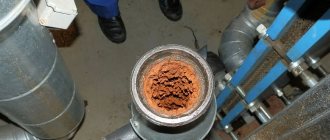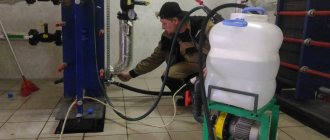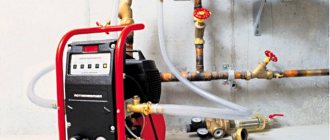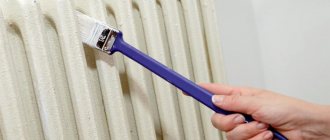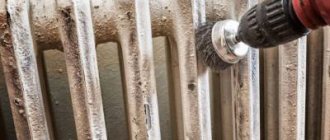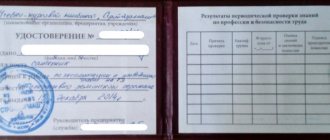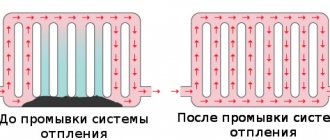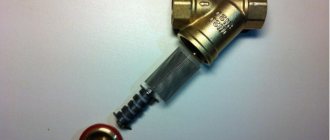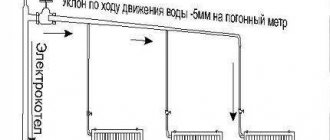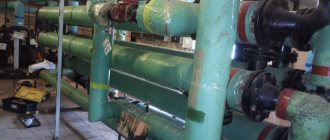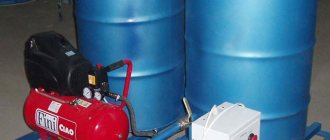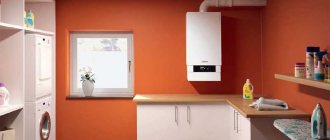Every heating system contains small particles that constantly circulate along with the liquid through the pipes. Most often, such substances are rust, scale or similar elements. When a lot of these components accumulate, problems begin with heating. Debris gets stuck in one place and begins to form deposits, which interfere with normal water circulation, and, consequently, heat exchange becomes worse. Of course, there is a solution to this problem - flushing the heating system.
The editors of the YaNashla website have prepared for you a rating of the best heating system cleaning products for 2022.
Is flushing the system necessary?
It is important to understand that not all apartments and private houses need washing. Since modern manufacturers are creating more innovative devices that do not accumulate sediment. And when heat exchange deteriorates, this does not always indicate pollution. Airing is common; this occurs after filling the system with new fluid. To eliminate this, first remove all the air, then add antifreeze or water. At first (about 2-3 weeks), the coolant will release sediment - this is a normal process, the main thing is to constantly clean the filters where it will fall out. After some time, when the impurities are exhausted, the precipitation of particles will stop.
When a person uses such a system (closed type), it will work for many years without any cleaning. The opposite situation is when heating needs constant replenishment from the outside. Then a person cannot avoid the formation of sediment. After 3-4 years, a large amount of debris will accumulate in the pipes, and sludge will form in the batteries. In this case, flushing is required.
A similar effect can occur due to the penetration of air into a closed system. The bubbles will begin to cause corrosion of the metal elements, which will cause the formation of iron oxide, which will accumulate in the filter all the time. The problem here will not be bad water, but plastic pipes that were manufactured without a protective oxygen barrier.
To ensure that the pipes begin to heat up again and do not leave the owner in the cold, the system should be flushed. But besides this, the cleaning process must be carried out:
- When heating appliances stop giving off heat. This can happen with one element or with several. The first sign is uneven heating of the sections when the bottom is completely cold. It should be understood that standard situations were considered and eliminated, but this did not affect heat transfer.
- When the heating system is constantly filled with fresh water or another substance. This often occurs when a person uses an electrode boiler, since in order for it to function normally, it is necessary to add water with a specific salt value. So the owner constantly monitors the chemical reaction and controls the level of salts or adds new coolant to automate the process.
- When a large amount of oxygen penetrates into the water. Signs of this problem are daily clogging of the sump tank and poor heat transfer, while the boiler operates at its maximum capacity.
If such problems occur, then the only solution is to flush the heating system. In this case, you can forget about frequency, since everything needs to be cleared so that the situation does not get worse. When the user is connected to central heating, then everything is much simpler, since the radiator network is flushed annually, after this stage pressure testing is carried out. It is carried out according to special standards.
Methods for cleaning heating systems
The use of one or another cleaning method will depend on the length of the heating system channels, the volume of coolant transferred, and other parameters, so it is possible to use several options:
- Mechanical;
- Hydrodynamic;
- Hydropneumatic;
- Electrohydropulse;
- Chemical.
The first and last methods can be completely carried out by the owner of the premises independently with the help of simple improvised means (hose, tank) or liquids (chemical solutions). The rest will require special equipment or the invitation of specialists who perform such work on a contract basis.
However, when using any of the above methods, it is necessary to follow certain rules, violation of which can make cleaning ineffective. Therefore, before starting any procedure, you must familiarize yourself with the procedure for carrying it out.
The first method is mechanical flushing
It is necessary to make a reservation right away that such cleaning is primarily aimed at removing floating debris in the batteries, and to a lesser extent it is capable of removing scale formed on the inner walls of the channel. If the design contains a circulation pump, expansion tank and shut-off valves, then they will have to be cleaned manually and separately.
You need to start cleaning by closing the valves that limit the flow of water into the channels. In private houses they are located in front and behind the boiler, and in apartment buildings they are located in the basements.
Next, you need to drain the water from the channels. To do this, there must be a special tap, which is installed during the installation of the entire circuit. If it is missing, then you can use a simple plug on the battery by simply unscrewing it. The main thing is that you need to choose a plug that is located further and lower than all the available ones.
It is better to drain the water carrier using a regular hose, which should be discharged into the toilet or into a large container. After draining, you simply need to open the valves, starting a new flow of water.
Method two - hydrodynamic flushing
To use this method, you cannot get by with a simple hose, but you will also need special equipment - a pump operating under high pressure. In some cases, the pump is specially connected to the gap in the heating ducts as far as possible from the point of discharge of dirty water. However, by and large, this will not matter if you use a special hose with an end cap. The end nozzle will have small diameter holes through which water will come out under high pressure.
It is the effect of water supplied under high pressure that will allow extremely effective removal of dirt/salt deposits inside the pipes. And the hose itself can be specially connected to the most problematic areas of the circuit, which were identified in advance in places where the radiator is not warmed up sufficiently.
When choosing a hose for hydrodynamic flushing, it is necessary to take into account the parameter of its rigidity - the stiffer the hose, the farther from the inlet pressure can be applied. However, this only applies to straight sections; at channel turns, the effect will be noticeably reduced. Experts advise that when carrying out hydrodynamic flushing, you need to sequentially and separately flush each section of the entire circuit, and not hope that an instant effect will be achieved if you flush the entire system from one end to the other.
Method three - hydropneumatic cleaning
This method is the most labor-intensive and expensive, but at the same time the most effective. To implement it, you will need rather bulky equipment - a special compressor equipped with a pneumatic gun. The essence of the hydropneumatic method is to supply increased air pressure inside the heating system, while super-strong turbulent flows with enormous kinetic energy are created inside the channels. Due to this process, build-ups are torn off from the inner surface of the pipes and accumulated dirt is blown out of the radiators.
It should be noted that the flows do not flow along the contour permanently, but periodically in the form of short-term shocks and bursts, which are created by means of a pneumatic gun. The compressor itself is connected to the system through a check valve. It is this connection that prevents water from flowing into the compression apparatus.
Hydropneumatic cleaning can be done both without dismantling the batteries and with it. In the first case, you need to remove the plug on the farthest/lowest radiator and use an adapter on the hose to discharge garbage and dirty water into the toilet or a large container. The compressor and air gun should be connected to the farthest and highest radiator. The first pumping of air should be carried out in a direction that will be opposite to the direction of normal coolant circulation. To increase the efficiency of the entire procedure, you need to change the direction of the air supply and garbage discharge, swapping the connection location of the compressor and the garbage hose several times.
The efficiency of hydropneumatics can be increased several times by performing the procedure on removed radiators. This will be due to the fact that on the dismantled radiator the blowing area will be much smaller; accordingly, the air flow, passing over a smaller area, will lose less of its strength, providing better cleaning of the channel walls. At the same time, you will be less likely to worry about the presence of debris that may remain in the channels after cleaning, since it will be successfully washed out with water upon first connection.
Method four - electrohydropulse
The essence of using this method is to use an electrical impulse, through which salts that settle on the walls of pipelines are destroyed. The peculiarity of this method is precisely expressed in the fact that it is aimed specifically at combating such pollution, and the walls of the channels themselves are not subject to any damage.
To produce an electric pulse, a special electric generator with special attachments is used. When connected via a coaxial cable, the electric pulse installation generates an electric discharge at the end of the nozzle, the shock wave of which easily destroys all salt deposits. Upon completion of cleaning, the entire heating system must be flushed with water to remove any remaining foreign particles. The main advantage of this method is that it almost does not require any serious disassembly of the entire heating circuit, and the removed slag can be simply washed down the drain without fear.
Method five - washing with chemical solutions
Today this is the most common way to deal with blockages in heating system circuits. Most homeowners like this method because it requires a minimum of effort, and even more so, it does not require dismantling the radiators at all.
The disadvantages of this method include the fact that not all mixtures can successfully interact with certain types of batteries. For example, highly caustic solutions are absolutely not suitable for aluminum batteries. And the waste liquid must (usually) be disposed of in a special way and in special places, and not simply poured into the sewer.
In cases where a preliminary check does not reveal any particular contamination in the system, the following products can be used for preventive cleaning:
- Caustic soda;
- Highly concentrated vinegar solution;
- Commonly available acids (orthophosphoric/phosphoric);
- Whey, etc., etc.
In other cases, it will be preferable to use specialized industrial compositions: usually their packaging describes in detail the symptoms of contamination that a particular liquid combats, recommendations are given on pipe materials in which this composition can be used, and detailed and step-by-step instructions are also provided by application.
For particularly strong cleaning liquids, it is necessary to strictly adhere to the time intervals during which the reagents act. At the same time, it is worth remembering that for autonomous systems it is necessary to periodically turn on the pump for uniform circulation throughout the entire coolant circuit, which contains the cleaning liquid.
In order to effectively destroy scale/dissolve foreign particles in the flow, after pumping liquid into the circuit, it must be left there for a period of from several hours to several days. After maintaining a certain period of time, the entire pipeline must be flushed with clean water in order to reduce the effect of chemical cleaning agents on the internal walls of the pipes.
The chemical method also has a gentle cleaning option - it is called dispersed. With it, a separate reagent is introduced into the pipeline, which dissolves only foreign particles floating in the flow or weakly attached to the walls of the channels. In this case, there is no damage to the material from which the pipes are made. Completion of the dispersed procedure is similar to the usual one - complete cleaning of the pipeline with clean water.
Rating of the best concentrates for the heating system
TermoTactic CleanMaster
A good concentrate, which is intended for use in heating, ventilation and air conditioning systems. Thoroughly remove scale, traces of corrosion and carry out disinfection. The composition is completely safe for metal products and will not damage them during the cleaning process.
Sold at a price of 1,600 rubles per 10 kg.
TermoTactic CleanMaster
Advantages:
- High cleaning properties;
- Resistance even in hard water;
- Biodegradability rate;
- Disinfection;
- Removes the fat layer.
Flaws:
- Not found.
Dixis LUX / 10l
A budget option that is suitable for every heating system. In a short time it will remove the formed scale, silt and other harmful elements. Thanks to the high-quality composition, the formation of suspension and sedimentation are eliminated, which improves performance properties.
The average price is 1,440 rubles.
Dixis LUX / 10l
Advantages:
- Efficiency;
- High-quality cleaning;
- Easy to use;
- Restorative effect.
Flaws:
- Not found.
SteelTEX IRON
An excellent concentrate that is suitable for household and professional use. After its use, the heating system will begin to work more efficiently and guarantees the user high-quality cleaning. Scale and rust dissolve in strong acids, but this does not affect the internal appearance of metal elements.
The average price is 2,270 rubles.
SteelTEX IRON
Advantages:
- High-quality cleaning;
- Speed of work;
- Does not interact with main parts;
- Suitable for professional use.
Flaws:
- Price.
When it is necessary to flush
Cleaning the heating system will be necessary if you see the following signs in the operation of the heating supply:
- a drop in temperature in the home when the boiler is constantly operating;
- the pipes heat up excessively slowly;
- heating parts heat up unevenly;
- the pipe lines are hot and the heating devices are cold;
- Fistulas often begin to appear in the pipes, and sometimes ruptures occur.
The manifestation of at least one of these signs may indicate that the heating system is clogged.
TOP powdered substances
BWT Cilit Neutra P
A powder substance that is used to neutralize an acid solution after flushing the heating with a chemical liquid. Before use, you must dilute the product in water; during this process, you must follow the instructions.
The average price is 3,700 rubles.
BWT Cilit Neutra P
Advantages:
- Cost-effective, since a small volume of powder can neutralize tens of liters of acid;
- Sold in durable packaging, which makes the product easy to store and transport;
- Effective acid neutralization.
Flaws:
- Not found.
SteelTEX ZINC
Concentrated powder that can effectively clean heating elements from traces of various contaminants. Used for both home and professional purposes. Compatible with all main materials used in the production of radiators.
The average price is 5,300 rubles.
SteelTEX ZINC
Advantages:
- Contains strong acids;
- Durable and convenient packaging;
- Does not cause corrosion;
- Easy to use.
Flaws:
- High price.
Why does pollution appear?
Corrosion is considered to be the problem with clogging of pipelines made of metal. Accumulating in the middle of the system, it interferes with the free circulation of the coolant, and as a consequence, interruptions occur in the operation of the water-type heating system.
As for plastic pipes, they are naturally not prone to rust, but still, scale appears on their walls, which also helps the heating system malfunction.
One of the causes of pollution is also considered to be the quality of water, which contains various impurities that are the basis for clogging of pipes.
Similarly, there are the following blockage options:
Rating of solutions that are immediately ready for use
Perkhim Medesk
Sold in a canister (20 liters) and is suitable for organizing effective flushing of the heating system. It is used by many professionals as the main remedy, since it contains excellent components that can remove scale and dirt in a short period.
The average price is 4,330 rubles.
Perkhim Medesk
Advantages:
- Good cleaning;
- Easy to use, as there is no need to dilute anything;
- Does not affect metal elements.
Flaws:
- Not found.
Syntilor Watesup 11 kg
One of the best ready-made products designed for quick cleaning. The product can be used in homes where plastic or metal pipes are used. Limestone and corrosion are removed quickly and efficiently. The product cleans the heating efficiently and does not damage the sealing parts.
The average price is 2,400 rubles.
Syntilor Watesup 11 kg
Advantages:
- Efficiency;
- Speed of action;
- Easy to use;
- Convenient packaging.
Flaws:
- Not found.
How to flush heating
You can purchase various reagents in the retail chain, offered in 3 types:
- liquid concentrate;
- powder;
- ready solution.
The concentrate and powder must be diluted with water, following the manufacturer's instructions. As a rule, before cooking, the water is heated to 40...60 °C. The finished liquid for flushing the heating system is poured into a barrel and disposed of after use.
We will give a number of recommendations on the best way to flush heating pipes:
- The active ingredients of the reagent should not damage the elements of your system, for example, interact with aluminum radiators. Choose chemistry taking into account the materials from which metal parts and fittings are made.
- It is better to buy washing with various useful additives - corrosion inhibitors, biodegrading additives.
- Based on their composition, the reagents are divided into 2 groups – acidic and alkaline. The former act faster, but are considered more aggressive towards equipment and hazardous to health. It is better to choose an alkaline concentrate.
We do not recommend using various folk remedies for washing, in particular citric acid. Firstly, it is only effective against scale, which is found only in boiler heat exchangers. Secondly, a high concentration of the acid solution is required; with a large amount of water it cannot be achieved.
Note. Factory-made reagents can be discharged into the general sewer system; no additional treatment is required.
How to temporarily remove a heating radiator
This article is about how to temporarily remove a heating radiator. to replace it or paint the wall behind it. Removing the radiator is not at all difficult, as it might seem at first glance; we will talk about this in the article. First of all, you must understand the consequences of a failed attempt to remove the radiator: if you do not know how to remove the radiator correctly, a leak may subsequently appear and you will ruin the flooring
However, if you pay attention to our tips, you will eliminate all problems at once during the radiator removal process
First of all, we must show you the main elements of the radiator: at the top right - the control valve, at the bottom left - the shut-off valve (for regulating the water supply), at the top left - the Mayevsky valve for bleeding air from the heating radiator.
Using a control valve, you can adjust the flow of incoming water into the radiator by opening or closing the valve, you will regulate its heating temperature by increasing and decreasing it accordingly. Using the shut-off valve, you can adjust the intensity at which the water will flow out. Most often, such a valve is used to balance all radiators and is installed on each one.
First of all, close the valves. The adjusting one is closed by hand, and the locking one is closed using a hex key.
TIP: When you close the shut-off valve, remember how many turns you made so that you can then open it the same amount.
Now you need to disconnect the radiator from the valves. To do this you will need a wrench or a gas wrench. The faucet structure consists of an American type (removable coupling). Unscrew the American nut to separate the radiator from the valve.
TIP: To avoid damaging the flooring, place unnecessary rags under the radiator.
Unscrew the shut-off valve...
We unscrew the control valve in the same way... For reliability, use a second wrench to hold the American fitting while unscrewing the nut.
The last step is to remove the radiator from the brackets. The best advice we can give you is that you remove the radiator with someone, as a radiator with water is very heavy. This operation requires at least two people.
ADVICE. If you will be painting the wall behind the radiator, seal the valves in bags or paper.
During the process of painting or gluing the wall, place the radiator so that it does not get scratched. When you are finished painting, hang the new radiator you bought or the old one on the brackets.
With the radiator hanging in place, connect the valve and radiator using an American tie rod. When tightening the shut-off valve, remember the number of turns you had to turn to close it and open it exactly the same amount.
Open the control valve to supply coolant, while you need to open the Mayevsky tap so that air comes out through it and the radiator is filled with water. After water drips from the Mayevsky tap, turn it off, this will mean that the radiator is filled with coolant.
Thanks for reading our article on how to temporarily remove a radiator. and our other articles. Don't forget to Love our projects and share them with your friends using social widgets.
Cleaning cast iron radiators is not a problem
Rinse the cast iron heating radiator, as it is heavy, which in itself is inconvenient. In addition, due to the design features, it silts heavily.
To remove a cast iron battery you will have to work hard - as a rule, the connecting couplings and taps are rusted, so it will be difficult to unscrew them. Start by draining off any remaining water. To do this, unscrew the plug at the top, place a basin or other container under the bottom and begin to unscrew it easily.
We recommend: What is a bithermal heat exchanger and its pros and cons
Important!!! On cast iron radiators, the plugs can be with either left-handed or right-handed threads.
If the plugs are painted, use solvent or White Spirit to remove the paint from where it connects to the section. After that, try to unscrew it with a gas wrench. If it does not flow, use a rust converter, for example, WD-40.
When the remaining water has been drained, it is necessary to disconnect the cast iron radiator from the common line. Usually it is mounted on special couplings (see photo). As with plugs, couplings can also become rusty. Instead of couplings, valves, taps or fittings can be installed. In this case, you will need to unscrew them.
Such couplings usually connect pipes in heating systems with cast iron radiators.
It is best to wash a cast iron battery in a bathtub, which must be completely covered with rags or rags so as not to damage the enamel coating or acrylic.
First, clean the bottom and top using rags. You may need something like a metal rod to remove any stubborn dirt, especially at the bottom.
After this is done, you need to tighten the plugs at the bottom of the cast iron radiator and pour liquid or flushing solution into it. Let it sit for as long as required by the rules of use, then drain it by unscrewing the bottom plug.
Screw the cap back on at the bottom and fill all sections with hot water. Let it sit for 3-5 minutes and drain. Repeat the procedure until the water coming out is as clean as the water coming in.
The level of contamination of cast iron radiators is higher than bimetallic and aluminum ones. Therefore, repeat the cleaning procedure again. You may have to do this 3-4 times.
Battery flushing
It is most convenient to wash batteries in large containers . Considering the low weight of the products, the best option would be to process the equipment in a bath. The first cleaning is carried out without the use of chemicals . The radiator is filled with water and dirt is mechanically removed from it using shaking.
The spent contents of the device should be poured out , and special reagents should be poured . The solution is kept inside the battery for about an hour , after which the equipment is knocked with a wooden hammer or shaken to remove any remaining rust and dirt. At the end, the device is rinsed in running water .
How to prepare for the procedure
For flushing, you need to find the necessary devices, because you may need to dismantle the radiator and then put it back. Gather all the tools. You will also need to find rags and use the bathroom. If you live in your own home and can take the battery outside for washing, that’s even better. In apartments, the procedure is usually performed in the bathtub. Be sure to do the work carefully so as not to damage the batteries themselves and the plumbing.
How often should you clean your heating system?
If you are asking this question, then you are probably quite careful about your own heating system.
There are two cleaning methods:
- The initial flushing is carried out immediately after the heating system has been installed, due to the fact that during the installation of heat supply, various types of debris or oily contaminants can get inside the pipes. Therefore, the flushing procedure should be performed until the water in the drain becomes clear.
- Experts recommend doing regular flushing in systems that are equipped with pipes made of metal 2 times a year - before the start of the heating season and after it ends. For plastic pipes, it is worth cleaning once a year - at the beginning of the heating season.
That's right, if you are wondering, is it possible to wash a pipe system on your own? The answer is yes. To do this, you just need to choose the best washing option, which we’ll talk about later in the publication.
